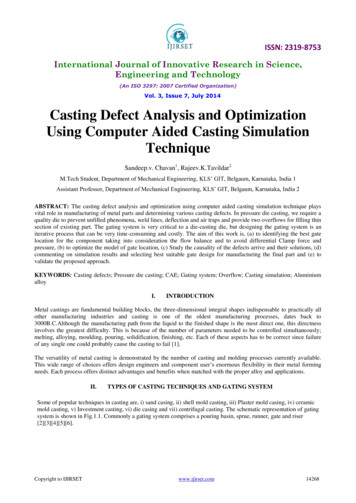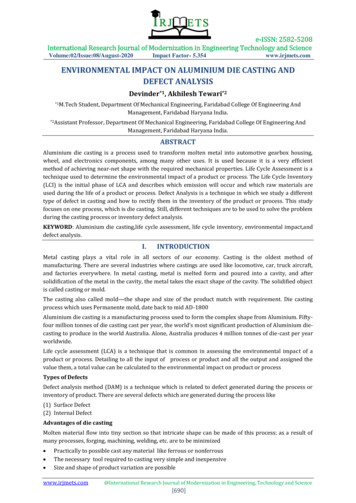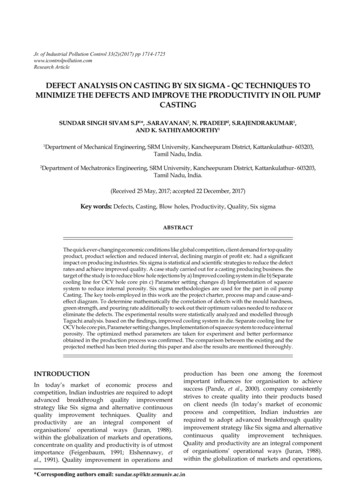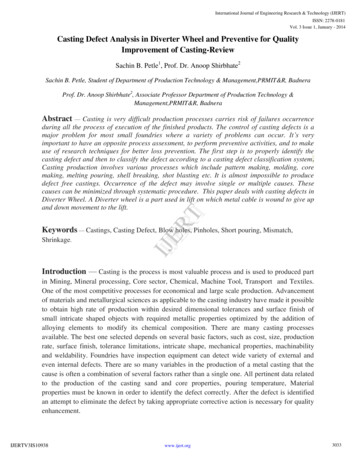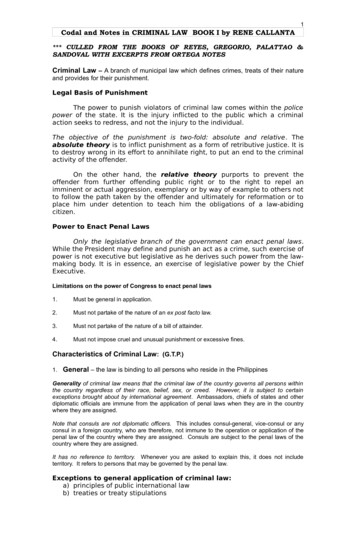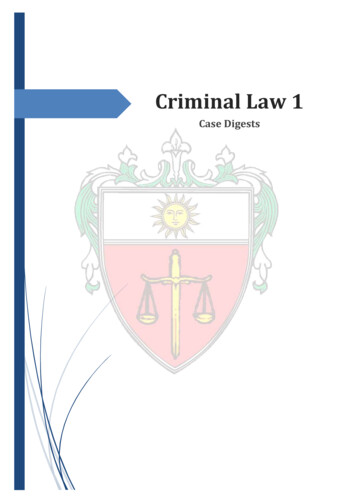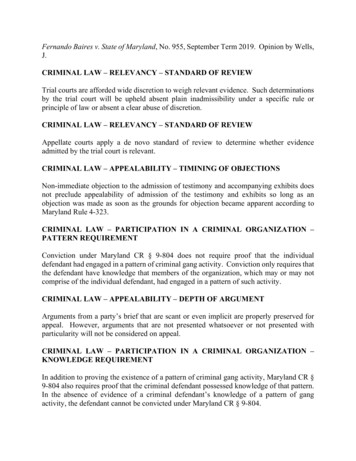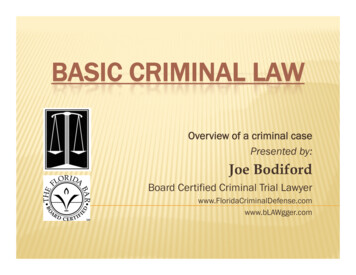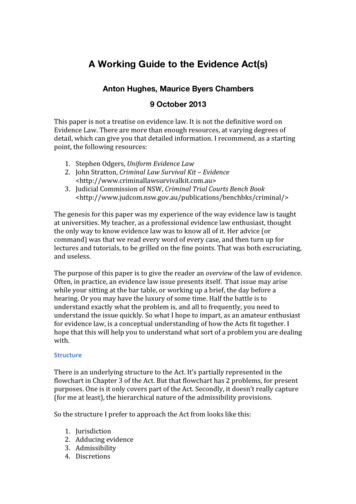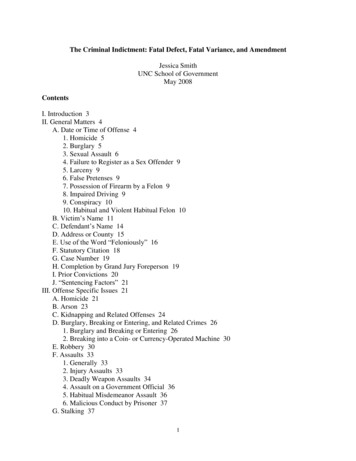
Transcription
The Criminal Indictment: Fatal Defect, Fatal Variance, and AmendmentJessica SmithUNC School of GovernmentMay 2008ContentsI. Introduction 3II. General Matters 4A. Date or Time of Offense 41. Homicide 52. Burglary 53. Sexual Assault 64. Failure to Register as a Sex Offender 95. Larceny 96. False Pretenses 97. Possession of Firearm by a Felon 98. Impaired Driving 99. Conspiracy 1010. Habitual and Violent Habitual Felon 10B. Victim‘s Name 11C. Defendant‘s Name 14D. Address or County 15E. Use of the Word ―Feloniously‖ 16F. Statutory Citation 18G. Case Number 19H. Completion by Grand Jury Foreperson 19I. Prior Convictions 20J. ―Sentencing Factors‖ 21III. Offense Specific Issues 21A. Homicide 21B. Arson 23C. Kidnapping and Related Offenses 24D. Burglary, Breaking or Entering, and Related Crimes 261. Burglary and Breaking or Entering 262. Breaking into a Coin- or Currency-Operated Machine 30E. Robbery 30F. Assaults 331. Generally 332. Injury Assaults 333. Deadly Weapon Assaults 344. Assault on a Government Official 365. Habitual Misdemeanor Assault 366. Malicious Conduct by Prisoner 37G. Stalking 371
H. Resist, Delay, and Obstruct Officer 37I. Disorderly Conduct 38J. Child Abuse 38K. Sexual Assault 38L. Indecent Liberties 42M. Larceny, Embezzlement, and Related Offenses Interfering With Property Rights 42N. Receiving or Possession of Stolen Property 49O. Injury to Personal Property 49P. False Pretenses and Forgery 501. False Pretenses 502. Identity Theft 513. Forgery 52Q. Perjury and Related Offenses 52R. Habitual and Violent Habitual Felon 53S. Drug Offenses 571. Sale or Delivery 572. Possession and Possession With Intent to Manufacture, Sell or Deliver 593. Trafficking 594. Maintaining a Dwelling 595. Drug Paraphernalia 606. Obtaining Controlled Substance by Fraud or Forgery 607. Amount of Controlled Substance 618. Drug Name 62T. Weapons Offenses and Firearm Enhancement 631. Shooting into Occupied Property 632. Possession of Firearm by Felon 643. Possession of Weapon of Mass Destruction 654. Firearm Enhancement 65U. Motor Vehicle Offenses 661. Impaired Driving 662. Habitual Impaired Driving 663. Speeding to Elude Arrest 674. Driving While License Revoked 68V. General Crimes 681. Attempt 682. Solicitation 693. Conspiracy 694. Accessory After the Fact to Felony 70W. Participants in Crime 702
I.IntroductionTo pass constitutional muster, an indictment ―must allege lucidly and accurately all theessential elements of the [crime] . . . charged.‖1 This requirement ensures that the indictment will(1) identify the offense charged; (2) protect the accused from being twice put in jeopardy for thesame offense; (3) enable the accused to prepare for trial; and (4) enable the court, on convictionor plea of nolo contendere or guilty, to pronounce sentence according to the rights of the case.2 Ifthe indictment satisfies this requirement, it will not be quashed for ―informality or refinement.‖3However, if it fails to meet this requirement, it suffers from a fatal defect and cannot support aconviction.As a general rule, an indictment for a statutory offense is sufficient if it charges theoffense in the words of the statute.4 However, an indictment charging a statutory offense neednot exactly track the statutory language, provided that it alleges the essential elements of thecrime charged.5 If the words of the statute do not unambiguously set out all of the elements of theoffense, the indictment must supplement the statutory language.6 Statutory short formindictments, such as for murder, rape, and sex offense, are excepted from the general rule that anindictment must state each element of the offense charged.7Although G.S. 15A-923(e) states that a bill of indictment may not be amended, the term―amendment‖ has been construed to mean any change in the indictment that ―substantially1. State v. Hunt, 357 N.C. 257, 267 (2003) (quotation omitted). See generally G.S. 15A-924 (contents ofpleadings).2. See Hunt, 357 N.C. at 267; State v. Hines, 166 N.C. App. 202, 206-07 (2004).3. G.S. 15-153.4. See, e.g., State v. Wade, 161 N.C. App. 686, 692 (2003).5. See, e.g., State v. Hunter, 299 N.C. 29, 40-42 (1980) (although kidnapping indictment did not track thelanguage of the statute completely, it did charge every necessary element).6. See State v. Greer, 238 N.C. 325, 328-31 (1953); State v. Partlow, 272 N.C. 60, 65-66 (1967).7. See Hunt, 357 N.C. at 272-73; see also infra pp. 21-23 (discussing short form for murder in more detail) andpp. 38-41 (discussing short forms for rape and sex offense in more detail).3
alter[s] the charge set forth in the indictment.‖8 Thus, amendments that do not substantially alterthe charge are permissible.Even an indictment that is sufficient on its face may be challenged. Specifically, anindictment may fail when there is a fatal variance between its allegation and the evidenceintroduced at trial. In order for a variance to be fatal, it must pertain to an essential element of thecrime charged.9 If the variance pertains to an allegation that is merely surplusage, it is not fatal.10Fatal defects in indictments are jurisdictional, and may be raised at any time.11 However,a dismissal based on a fatal variance between the indictment and the proof at trial or based on afatal defect does not create a double jeopardy bar to a subsequent prosecution.12The sections below explore these rules. For a discussion of the use of the conjunctiveterm ―and‖ and the disjunctive term ―or‖ in criminal pleadings, see Robert Farb, The ―Or‖ Issuein Criminal Pleadings, Jury Instructions, and Verdicts; Unanimity of Jury Verdict (Faculty Paper,Jan. 1, 2008) (available on-line at www.iogcriminal.unc.edu/verdict.pdf).II. General MattersA. Date or Time of OffenseG.S. 15A-924(a)(4) provides that a criminal pleading must contain ―[a] statement or crossreference in each count indicating that the offense charged was committed on, or on or about, adesignated date, or during a designated period of time.‖ Also, G.S. 15-144 (essentials of bill forAlso, G.S. 20-138.1(c) allows a short form pleading for impaired driving. G.S. 20-138.2(c) does the same forimpaired driving in a commercial vehicle.8. See State v. Price, 310 N.C. 596, 598 (1984) (quotation omitted).9. See, e.g., State v. Langley, 173 N.C. App. 194, 197 (2005).10. See infra pp. 4-70 (citing many cases distinguishing between fatal and non-fatal defects).11. See, e.g., State v. Snyder, 343 N.C. 61, 65 (1996); State v. Sturdivant, 304 N.C. 293, 308 (1981).12. See State v. Stinson, 263 N.C. 283, 286-92 (1965) (prior indictment suffered from fatal variance); State v.Whitley, 264 N.C. 742, 745 (1965) (prior indictment was fatally defective); see also State v. Abraham, 338 N.C.315, 339-41 (1994) (noting that proper procedure when faced with a fatal variance is to dismiss the charge and grantthe State leave to secure a proper bill of indictment); State v. Blakney, 156 N.C. App. 671 (2003) (noting thatalthough the indictment was fatally defective, the State could re-indict).4
homicide), G.S. 15-144.1 (essentials of bill for rape), and G.S. 15-144.2 (essentials of bill for sexoffense) require that the date of the offense be alleged.13 However, a judgment will not bereversed when the indictment fails to allege or incorrectly alleges a date or time, if time is not ofthe essence of the offense and the error or omission did not mislead the defendant.14 Likewise,when time is not of the essence of the offense charged, an amendment as to date does notsubstantially alter the charge. Time becomes of the essence when an omission or error regardingthe date deprives a defendant of an opportunity to adequately present his or her defense,15 suchas when the defendant relies on an alibi defense16 or when a statute of limitations is involved.17The cases summarized below apply these rules.1. HomicideState v. Price, 310 N.C. 596, 598-600 (1984) (no error to allow the State to amend date ofmurder from February 5, 1983—the date the victim died—to December 17, 1982—thedate the victim was shot).State v. Wissink, 172 N.C. App. 829, 835-36 (2005) (trial court did not err by allowingthe State to amend a murder indictment on the morning of trial; the original indictmentalleged that the murder occurred on or about June 26, 2000, and the evidence showed thatthe murder actually occurred on June 27, 2000), rev’d in part on other grounds, 361 N.C.418 (2007).2. BurglaryState v. Davis, 282 N.C. 107, 114 (1972) (no fatal variance when indictment alleged thatoffense occurred on November 13 but evidence showed it took place on November 14 of13. The short forms for impaired driving also require an allegation regarding the time of the offense. See G.S.20-138.1(c) (impaired driving); G.S. 20-138.2(c) (impaired driving in a commercial vehicle).14. See G.S. 15-155; G.S. 15A-924(a)(4); Price, 310 N.C. at 599.15. Price, 310 N.C. at 599.16. See State v. Stewart, 353 N.C. 516, 518 (2001). But see State v. Custis, 162 N.C. App. 715 (2004)(explaining that time variances do not always prejudice a defendant, even when an alibi is involved; such is the casewhen the allegations and proof substantially correspond, the alibi evidence does not relate to either the date chargedor that shown by the evidence, or when the defendant presents an alibi defense for both dates).17. See State v. Davis, 282 N.C. 107, 114 (1972) (variance of one day ―is not material where no statute oflimitations is involved‖).5
the same year; ―variance between allegation and proof as to time is not material where nostatute of limitations is involved‖) (quotation omitted).State v. Mandina, 91 N.C. App. 686, 690 (1988) (―[a]lthough nighttime is clearly ‗of theessence‘ of the crime of burglary, an indictment for burglary is sufficient if it avers thatthe crime was committed in the nighttime;‖ failure to allege the hour the crime wascommitted or the specific year does render not the indictment defective).State v. Campbell, 133 N.C. App. 531, 535-36 (1999) (no error to allow the State toamend burglary indictment to change date of offense from June 2, 1997 to May 27, 1997;time is not an essential element of the crime; defendant was neither misled nor surprisedby the change—in fact, defendant was aware that the date on the indictment wasincorrect).3. Sexual AssaultIn a sexual assault case involving a child, leniency is allowed regarding the child‘smemory of specific dates of the offense.18 The rule of leniency is not limited to very youngchildren, and has been applied to older children as well.19 Unless the defendant demonstrates thathe or she was deprived of his or her defense because of the lack of specificity, this policy ofleniency governs.20 The following cases illustrate these rules.Cases Finding a Fatal Defect or Variance/Error With Respect to an AmendmentState v. Stewart, 353 N.C. 516, 517-19 (2001) (indictment alleged that statutory sexoffense occurred between July 1, 1991 and July 31, 1991; the State‘s evidenceencompassed a 2 1/2 year period but did not include an act within the time period allegedin the indictment; defendant relied on the dates in the indictment to prepare an alibidefense and presented evidence of his whereabouts for each of those days; noting that arule of leniency generally applies in child sexual abuse cases but holding that the―dramatic variance‖ between the dates resulted in a fatal variance).State v. Whittemore, 255 N.C. 583, 592 (1961) (time was of the essence in statutory rapecase in which indictment alleged that offenses occurred on a specific date and in its casein chief, the State‘s witnesses confirmed that date; after defendant presented an alibidefense, the State offered rebuttal evidence showing that the crime occurred on a18. See, e.g., State v. Stewart, 353 N.C. 516, 518 (2001).19. See, e.g., State v. Ware, N.C. App. , 656 S.E.2d 662 (2008) (applying the rule to a case involving a 15year-old victim).20. See Stewart, 353 N.C. at 518.6
different date; the rule that time is generally not an essential ingredient of the crimecharged cannot be used to ―ensnare‖ a defendant).State v. Custis, 162 N.C. App 715 (2004) (fatal variance existed between dates alleged insex offense and indecent liberties indictment and evidence introduced at trial; theindictment alleged that the defendant committed the offenses on or about June 15, 2001;at trial there was no evidence of sexual acts or indecent liberties occurring on or aboutthat date; evidence at trial suggested sexual encounters over a period of years some timeprior to the date listed in the indictment; defendant relied on the date alleged in theindictment to build an alibi defense for the weekend of June 15).Cases Finding No Fatal Defect or Variance/No Error With Respect to an AmendmentState v. Sills, 311 N.C. 370, 375-77 (1984) (variance between actual date of rape, March14, 1983, and the date alleged in the indictment as ―on or about March 15, 1983‖ was notfatal; defendant was not deprived of his ability to present his alibi defense; defendant hadnotice that the offense date could not be pinpointed due to the victim‘s youth).State v. Baxley, 223 N.C. 210, 211-12 (1943) (although indictment charged that offensewas committed in April, 1942, victim testified at trial that the acts took place aboutSeptember, 1942, in December, 1941, and in April, 1942; time is not of the essence of theoffense of rape of a female under the age of sixteen).State v. Ware, N.C. App. , 656 S.E.2d 662 (2008) (in a case involving statutory rapeand incest, the court applied the rule of leniency with respect to a 15-year-old victim; thecourt noted that on all of the dates alleged, the victim would have been 15 years old).State v. Wallace, 179 N.C. App. 710, 716-18 (2006) (trial judge did not err by allowing amid-trial amendment of an indictment alleging sex offenses against a victim who was 13,14, or 15 years old; original dates alleged were June through August 2000, June throughAugust 2002, and November 2001; amendment, which
Sturdivant, 304 N.C. 293, 308 (1981). 12. See State v. Stinson, 263 N.C. 283, 286-92 (1965) (prior indictment suffered from fatal variance); State v. Whitley, 264 N.C. 742, 745 (1965) (prior indictment was fatally defective); see also State v. Abraham, 338 N.C. 315, 339-41 (1994) (noting that proper procedure when faced with a fatal variance is to dismiss the charge and grant the State leave .
